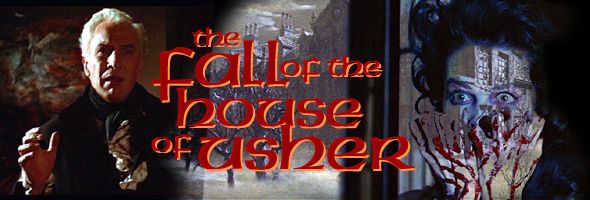
Color, 1960, 80 mins. Directed by Roger Corman
Starring Vincent Price, Mark Damon, Myrna Fahey, Harry Ellerbee / Music by Les Baxter / Written by Richard Matheson / Cinematography by Floyd Crosby
Format: DVD - MGM (MSRP $19.95)
Letterboxed (2.35:1) (16x9 enhanced) / Dolby Digital Mono
Philip Winthrop (Black Sabbath's Mark Damon) arrives at the foggy, foreboding estate of Roderick Usher (Vincent Price), a morose, obsessed man whose sister, Madeleine (Myrna Fahey), is destined to be Philip's bride. As Roderick explains, the Usher bloodline is cursed, and Madeleine has been afflicted with cataleptic trances which will one day soon prove to be her doom. Philip dismisses
Exquisitely mounted on a deceptively low budget, House of Usher is a colorful feast of macabre, overripe imagery, slim on plot but heavy on atmosphere. All of the ground rules for further Poe films are clearly laid out here, making this the horror equivalent of Dr. No. Floyd Crosby's expert scope photography, Price's brooding central performance, and Les Baxter's brash, emphatic music all combine for a cinematic experience which proved to be one of the most influential of its decade. While Corman later outdid this one in future entires, House of Usher still holds up extremely well, apart from the hamstrung special effects which render the final nightmarish inferno a tad less convincing than one might hope, even for 1960.
Until the long overdue widescreen laserdisc from Image/Orion, most viewers had to content themselves with horrifically cropped video editions of House of Usher which rendered the cinematography incomprehensible. The laser was a gem for its time, and the anamorphically enhanced MGM DVD is even better. Marvelously saturated colors and a very smooth compression job make this a joy for the eyes, and while the source material exhibits a few more signs of wear than the virtually immaculate laser, the enhanced clarity makes it more than an even trade. The mono audio is clear and stable, though a bit lower than normal. Apart from the new transfer, fans of the series will be overjoyed with the addition of the U.S. theatrical trailer and a feature length commentary by Roger Corman, who affectionately recalls the details of getting the film produced under the Nicholson/Arkoff regime of AIP and the methods he used to craft a sumptuous visual appearance with limited resources. A fine film, and an equally fine DVD release.
Color, 1962, 89 mins. Directed by Roger Corman
Starring Vincent Price, Peter Lorre, Basil Rathbone, Debra Paget, Maggie Pierce, Joyce Jameson / Music by Les Baxter / Written by Richard Matheson / Cinematography by Floyd Crosby
Format: DVD - MGM (MSRP $19.95)
Letterboxed (2.35:1) (16x9 enhanced) / Dolby Digital Mono
In the first and most traditional story, "Morella," Vincent Price portrays an embittered, alcoholic recluse who finally receives a visitor in the form of his estranged daughter, Lenora (Maggie Price), whom he blames for the death of his beautiful, egocentric wife, Morella. Lenora reveals that she only has a short time left to live, and she wanted to see her father before shuffling off into the void. Gradually the father and daughter show signs of forgiveness, but the malefic spirit of Morella intervenes with tragic, fiery results.
In "The Black Cat," a very loose spin on Poe's most graphic tale crossed with "The Cask of Amontillado," Peter Lorre is Montresor Herringbone, a drunken lout who spends his evenings at the tavern and ignores his wife, Annabel (Joyce Jameson, who later reprised the same basic role in Comedy of Terrors). One night Montresor engages in a humorous wine tasting contest with snobby connoisseur Fortunato (Price), which indirectly ignites an affair between Fortunato and Annabel. Naturally our sloshed antihero loses his mind and plots the perfect murder, but the family pet, a black cat, has other plans...
Finally, "The Facts in the Case of Mr. Valdemar" pairs up Price as a dying aristocrat with Basil Rathbone as Carmichael, an unscrupulous mermerist who uses hypnotism to alleviate his patient's pain. Unfortunately Carmichael abuses his position and manipulates a promise from Valdemar that his wife, Helene (Debra Paget), will wed Carmichael after her husband's demise. Things take a turn for the worse when Valdemar's body dies during a
Despite the title, there isn't a whole lot to be terrified about with Tales of Terror. Rather, it's a fascinating study in three different moods, with "The Black Cat" operating most successfully as a study in ghoulish humor. The silly tone would later dominate Corman's The Raven, but it really works best as an extended sketch. Lorre in particular dominates his every moment on film and proves to be a fine comedian, while his wine tasting scene with Price has justifiably become a fan favorite. (Note: for an amusing disorienting effect, try running Lorre's obligatory distorted nightmare sequence in 16x9 mode on a standard 4:3 television set.) "Morella" is beautifully filmed and highly atmospheric, but it's too brief and indifferently acted to rank up there with its obvious inspiration, House of Usher. "Valdemar" is basically a comic book treatment of a more serious story and, while somewhat strangely paced, benefits from a memorable gruesome finale which left a strong impression on more than a few matinee audiences. It all looks great as usual, with Floyd Crosby's adroit camerawork and Daniel Haller's inventive production design wringing every little visual detail out of the stories despite the low budget. Famed fantasy novellist Richard Matheson wrote the screenplay, which is literate enough but hard to separate from the other Corman scripts of the period.
MGM's DVD of Tales of Terror marks the second widescreen presentation of this film, which uses every inch of the Panavision frame and simply doesn't work at all in pan and scan. From the terrific animated segues with Price offering macabre bits of narration ("This is the heartbeat of a dying man...") to the simple payoff shot of "The Black Cat," you need to see the entire image just to understand what's happening before your eyes. The DVD is much brighter than the previous Orion/Image laserdisc (which was paired with the underrated The Premature Burial); this new presentation reveals many new details in the sets and costumes but also removes a great deal of the shadowy textures in the process. Overall the colors are well defined, and the clarity of a nice, mostly clean print in 16x9 is obviously the preferable choice in the long run. Apart from a couple of fleeting blemishes and some odd graininess during the second story, the elements seem to be in fine shape. The disc also includes the terrific theatrical trailer, also finally in scope. In short, this film makes for a handy intro to the Corman/Price/Poe cycle, which will hopefully be represented in its entirety on DVD someday.
Here's the one that started it all. While Roger Corman had been churning out drive-in quickies for several years and Vincent Price had earned his horror matinee idol status with William Castle gems like
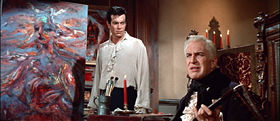 House on Haunted Hill, both men earned an entirely new level of respectability and popular acclaim with The Fall of the House of Usher (or, as most prints and marquees simply called it, House of Usher). Surprisingly close to the original Edgar Allan Poe story, this was one of the AIP studio's biggest hits at the time and set off a long, fruitful series of Corman/Price gothics, mostly based on other Poe stories.
House on Haunted Hill, both men earned an entirely new level of respectability and popular acclaim with The Fall of the House of Usher (or, as most prints and marquees simply called it, House of Usher). Surprisingly close to the original Edgar Allan Poe story, this was one of the AIP studio's biggest hits at the time and set off a long, fruitful series of Corman/Price gothics, mostly based on other Poe stories.
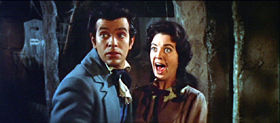 Roderick's claims, but then Madeleine seems to pass away and is interred in the family crypt. However, death is hardly the end for poor Madeleine and her possibly mad brother...
Roderick's claims, but then Madeleine seems to pass away and is interred in the family crypt. However, death is hardly the end for poor Madeleine and her possibly mad brother...
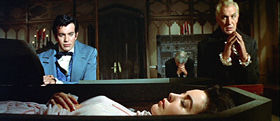
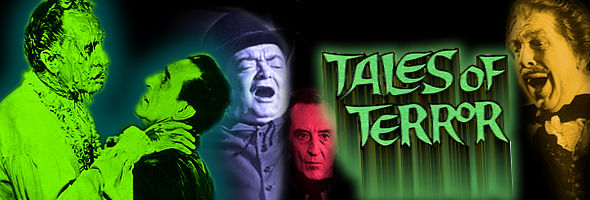
After striking gold with his Edgar Allan Poe adaptations starring Vincent Price, House of Usher and The Pit and the Pendulum, Roger Corman decided to tweak the formula a bit by presenting Poe's short stories as three vignettes, rather than dragging a ten page narrative kicking and screaming to an 80 minute running time. As with all horror anthologies, Tales
 of Terror has its highs and lows but makes for compelling viewing even during its weakest links.
of Terror has its highs and lows but makes for compelling viewing even during its weakest links.
 hypnotic state, resulting in horrific consequences for everyone involved.
hypnotic state, resulting in horrific consequences for everyone involved.
